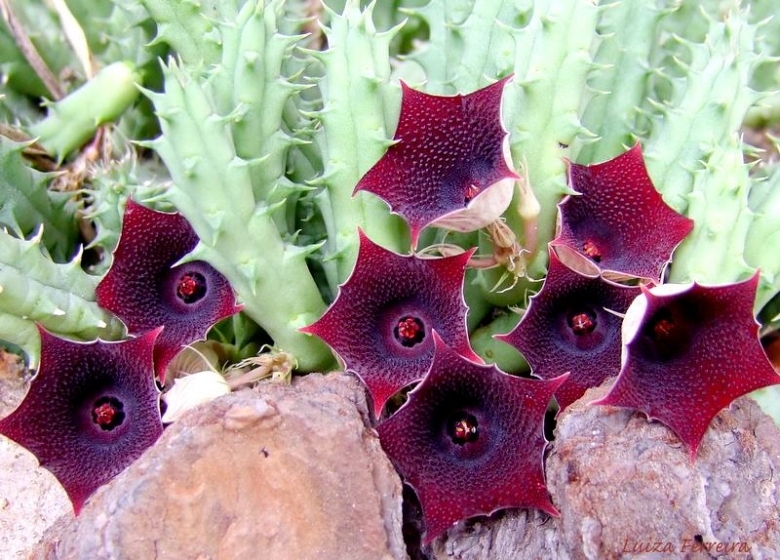Accepted Scientific Name: Huernia macrocarpa (A.Rich.) Sprenger
Cat. Dammann & Co. 59: 4, 7, fig, 6, l892

Huernia macrocarpa var. penzigii Photo by: Luiza Ferreira
Origin and Habitat: Ethiopia.
Synonyms:
See all synonyms of Huernia macrocarpa
Description: Huernia penzigiiSN|21257]]SN|21257]], also labelled Huernia macrocarpaSN|21254]]SN|21254]] var. penzigii, is a variable and ill-delined species differently assessed in different publications. According to Schumann, this plant is the same as Stapelia macrocarpaSN|21255]]SN|21255]], A. Rich., but Huernia penzigiiSN|21257]]SN|21257]] has bell-shaped flowers entirely of a uniform black-purple-red colour within. Corolla shallow bowl-shaped, about twice as wide as deep.
Stems: Erect or ascending, clumping 5-9 cm tall 12-16 mm thick, excluding the teeth, 5-angled. Teeth conical straight spreading 7-10 mm long, with elongated bristle tips.
Flowers: 1–5 in a fascicle at the base of the young stems, developing successively, inclined on stalks. Pedicels ca. 6 mm. long, glabrous. Sepals 8-12 mm long, lanceolate-subulate, spreading, glabrous. Corolla campanulate, 5-12 mm long, 12-18 mm in expanse, ca. 1 cm deep, black-purple to dark maroon with minute wart-like papillae within, otherwise glabrous, and not ciliate, pallid and rough outside. Corolla lobes 5, triangular, 5-7 mm long deltoid, slightly spreading. Outer corona lobes 5, transversely oblong, retuse or emarginate. Inner coronal-lobes 1.3-1.5 mm long, tapering from a swollen base, leaning inwards over the backs of the anthers, then erect, deltoid-subulate, with a transverse ridge behind at their base, glabrous, blackish-purple.
Bibliography: Major references and further lectures
1) Bill Keen “CACTI AND SUCCULENTS: Step-by-Step to Growing Succes” Crowood, 18 October 2011
2) White & Sloane. "The Stapelicae". Cdn 2. 3: 851-853 (1937) – as: H. macrocarpa
3) Excelsa Taxonomic Series 4: 108. 109 (1988)
4) James Cullen, Sabina G. Knees, H. Suzanne Cubey “The European Garden Flora Flowering Plants: A Manual for the Identification of Plants Cultivated in Europe, Both Out-of-Doors and Under Glass” Cambridge University Press, 11/August/2011
5) N. E. Brown. “Flora of Tropical Africa” Vol 4, Part 1, (1904)
6) Focke Albers, Ulrich Meve “Illustrated Handbook of Succulent Plants: Asclepiadaceae: Asclepiadaceae” Volume 4 Springer, 2002
Cultivation and Propagation: Not difficult to grow. Huernia require moderately watering through the growing season but enjoy plenty of water and some fertiliser in hot weather, this helps them to flower freely. Water more sparingly in winter according to temperatures. But, as with most asclepiads, it is unwise to leave them wet in cold weather.
Frost Tolerance: It is usually recommended to overwinter them in warm conditions (at 10 deg) but despite the African origin they seem to grow well and flower without the extra heat which one might have thought necessary and occasional temperature near 0 deg. are tolerated if kept dry.
Potting medium: Since roots are quite shallow, use a cactus mix or add extra perlite or pumice to regular soil potting soil. A gritty, very free-draining compost is suitable, and clay pots help the plants to dry out between watering.
Pest and diseases: Huernia species vary in their susceptibility to rotting, but are generally fairly easy to grow, especially if kept pest-free. They are very susceptible to stem and root mealy bugs, and damage from these may well initiate fungal attack. If you do have problems with a stem or with basal rotting, you can reliably isolate the healthy parts, dry them off, and re-root them in moist compost.
Propagation: Easiest with stem cuttings. Allow cuttings to dry a day before planting. Stems must be laid (Not buried) on gritty compost and will then root from the underside of the stems. It can also be increased from seeds sowing in spring in moist, sandy peat moss. Barely cover seeds. Seeds germinate quickly.










